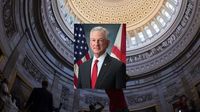In a move that has sent ripples through the nation’s public health community, the Trump administration on September 9, 2025, unveiled an ambitious new strategy to tackle the rising tide of chronic childhood diseases. The centerpiece of this effort is the Make America Healthy Again (MAHA) report, a 20-page blueprint released by Health and Human Services Secretary Robert F. Kennedy Jr. and backed by President Trump. The report proposes sweeping reforms to the way the United States addresses children’s health, with a particular focus on vaccine safety, autism research, nutrition, and environmental exposures.
President Trump wasted no time acting on the report’s recommendations. That same evening, he signed a memorandum to crack down on misleading pharmaceutical advertising across television, online, and social media platforms. According to administration officials, “hundreds” of warning letters will soon be sent to drug companies accused of running deceptive ads, marking a significant escalation in federal oversight of pharmaceutical marketing (as reported by Newsweek).
At the heart of the MAHA blueprint is Kennedy’s long-standing campaign to overhaul the country’s childhood immunization schedule and investigate vaccine injuries more thoroughly. The report argues that federal health agencies have failed to adequately address concerns about adverse vaccine reactions and calls for a new framework to ensure both the effectiveness and safety of vaccines. Kennedy, whose views on vaccines have long been a source of controversy, stated, “They will be welcomed and we will learn everything we can about them so we can improve the safety of these products.” He also pointed out that doctors are not currently compensated for filing complaints related to vaccine injuries.
The MAHA report’s recommendations don’t stop at vaccines. Autism, a complex developmental disorder whose causes have long been debated, also takes center stage. Kennedy has promised to reveal what he calls the true cause of autism, though the report itself stops short of providing a definitive answer. Instead, it directs the National Institutes of Health (NIH) to launch a major research initiative that will link insurance claims, electronic health records, and wearable-device data to explore possible causes of autism and other chronic diseases. As the MAHA report puts it, “The NIH will link multiple datasets, such as claims information, electronic health records, and wearables data, into a single integrated dataset for researchers studying the causes of, and developing treatments for, the chronic disease crisis.”
This sweeping vision, however, lands at a moment of significant upheaval within the federal health establishment. The Centers for Disease Control and Prevention (CDC) has been rocked by disputes over Kennedy’s vaccine agenda, culminating in the firing of its director and the departure of several senior staffers. On Capitol Hill, senators have pressed Kennedy over whether his approach is undermining public confidence in vaccines at a time when preventable childhood illnesses remain a threat (according to NPR).
The MAHA Commission, which drafted the report and is composed of Kennedy and other Trump cabinet officials, claims its goal is “radical transparency.” Yet, critics have pointed out that the group never held a public meeting before publishing its findings, raising questions about how evidence was weighed and considered. The final draft of the report, released on September 9, expands the NIH’s role in tracking chronic disease and ties those efforts to personal health data, even as the agency faces a proposed 40% budget cut—a move that has left many doubting whether Kennedy’s ambitious vision can be realized.
Beyond vaccines and autism, the MAHA plan casts a wide net. It identifies four key drivers behind the rise in chronic disease among children: poor diet, chemical exposure, lack of physical activity, and chronic stress, as well as what it terms “overmedicalization”—the overprescribing of medications to children. The report notes that 60% of the calories consumed by U.S. children come from highly processed foods and calls for a major educational campaign to promote updated government dietary guidelines, emphasizing whole foods and limiting processed products. The plan also advocates for removing restrictions on whole milk sales in schools and helping states limit the purchase of unhealthy items with federal food assistance (SNAP) benefits.
Physical inactivity among children is another major concern addressed by the MAHA report. The strategy calls for partnering with the President’s Council on Sports, Fitness, and Nutrition to revive the Presidential Fitness Test and promote more afterschool physical activity programs. An education and awareness campaign on screen time, to be led by the surgeon general (nominee Casey Means), is also in the works.
The report further acknowledges the potential harms of chemical exposure, listing substances such as PFAS, phthalates, bisphenols, microplastics, and agricultural pesticides as possible contributors to developmental issues and chronic disease. However, critics note that the MAHA plan offers few concrete changes to the regulation of pesticides, instead calling for ongoing evaluation of existing frameworks. According to NPR, this approach reflects the influence of agribusiness lobbying, with the American Farm Bureau expressing support for the commission’s willingness to consult with farmers.
One of the most contentious aspects of the MAHA strategy is its call for a new vaccine framework, which could mean revamping the childhood vaccine schedule and potentially giving parents more personal choice over vaccinating their children. Kennedy has already replaced several members of the CDC’s vaccine advisory committee with his own picks, including some who are critical of vaccines. These moves have drawn sharp criticism from public health advocates. The American Lung Association, for example, warned that the report “puts the childhood vaccine schedule in question, which sows mistrust in the established and science-based vaccine infrastructure.” They added, “Vaccines are a cornerstone of public health and the mistrust sewn in this report puts children’s lives at risk.”
Despite its 128 proposals covering research, policy changes, public awareness campaigns, and public-private partnerships, the MAHA report has been criticized for lacking a comprehensive blueprint for improving children’s health. Dr. Philip J. Landrigan of Boston College described it as “a very uneven, poorly conceived, disjointed hodgepodge of recommendations that reflect Secretary Kennedy’s preoccupations and little else.” Others, like Susan Mayne of Yale University, acknowledge the urgency of addressing chronic disease in children but question how the administration’s proposed funding cuts to food assistance, Medicaid, and scientific research align with the report’s lofty goals.
Supporters of the MAHA movement, which Kennedy frames as a bipartisan initiative to reform nutrition, water quality, medical oversight, and environmental health, argue that it marks a long-overdue reckoning with the nation’s health priorities. Yet, as the debate continues, many are left wondering whether the administration’s actions will match its rhetoric—and whether the ambitious MAHA agenda can overcome the political and financial obstacles now standing in its way.
The unveiling of the MAHA report has sparked a national conversation about the future of children’s health in America, highlighting both the urgent need for action and the deep divisions over how best to achieve it.

